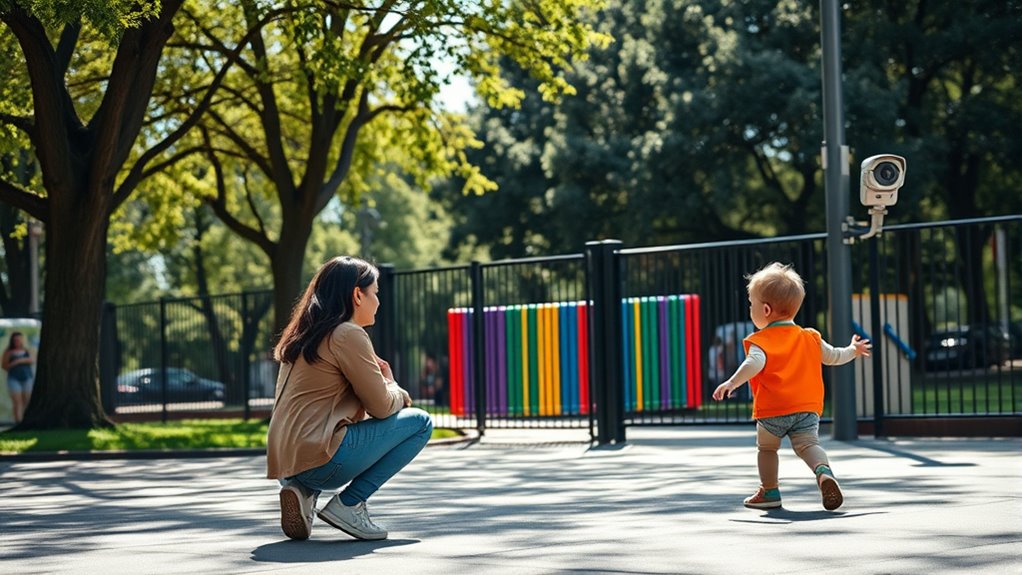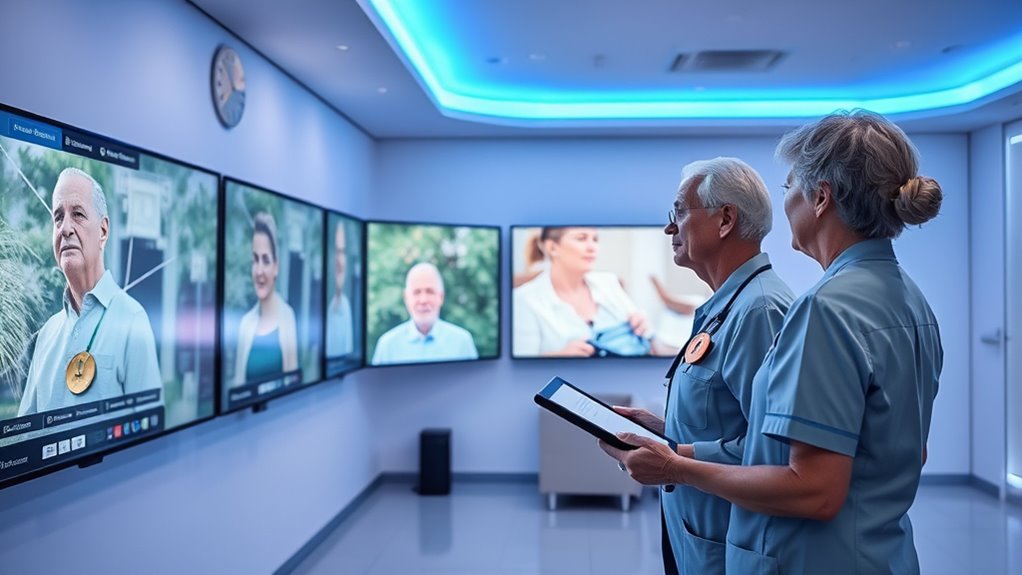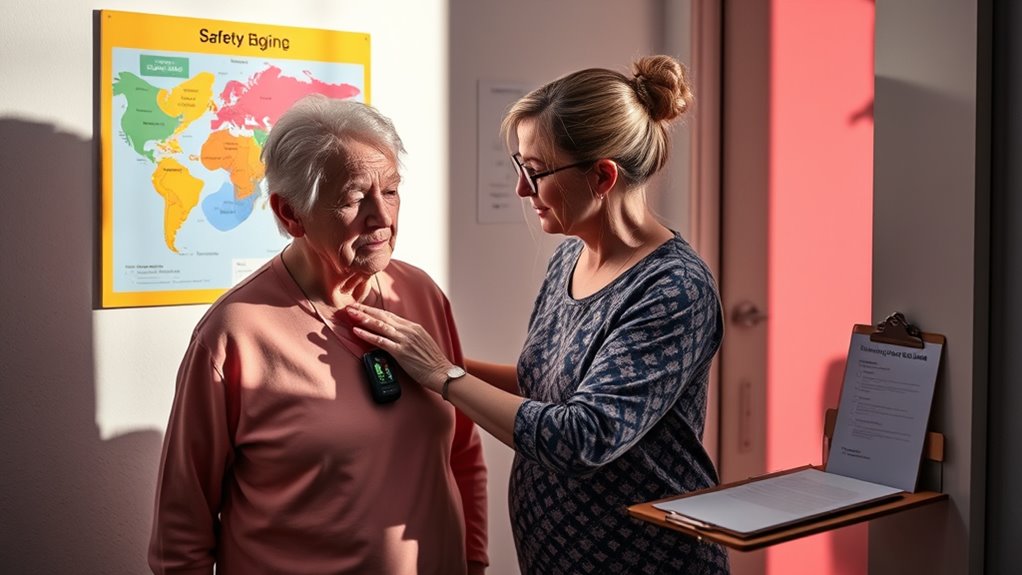To prevent wandering, you should understand the risks and identify triggers like confusion or environmental hazards. Create a safer environment by securing doors, removing clutter, and using good lighting. Supervise closely with routines and clear boundaries, and develop an emergency plan with specific steps. Utilize technology like GPS trackers and alarms for added safety. Educate caregivers and establish emotional support to manage stress. If you want to learn more, we’ll guide you through proven strategies for peace of mind.
Key Takeaways
- Secure doors and exits with locks and alarms to prevent unauthorized wandering.
- Establish and regularly practice safe routes and locations for emergency situations.
- Use monitoring devices like GPS trackers for real-time location updates.
- Maintain consistent routines and supervision strategies tailored to individual needs.
- Educate caregivers on recognizing early signs and implementing effective emergency response plans.
Understanding the Risks of Wandering

Wandering poses serious safety risks, especially for individuals with cognitive impairments such as Alzheimer’s or dementia. Understanding the risk factors helps you identify potential dangers. Common risk factors include confusion, fear, or boredom, which can trigger wandering behavior. Wandering triggers often involve environmental cues like unsecured doors, unfamiliar surroundings, or loud noises that cause disorientation. Stress and changes in routine also increase the likelihood of wandering. Recognizing these risk factors and triggers allows you to anticipate when your loved one might wander, so you can take proactive measures. Being aware of what prompts wandering helps you implement strategies to reduce these triggers, ultimately keeping your loved one safer and minimizing the chances of dangerous situations. Additionally, understanding divorce statistics and legal resources can provide peace of mind if caregiving challenges intersect with legal or family issues.
Creating a Safer Living Environment

To reduce the risk of wandering and keep your loved one safe, creating a secure living environment is essential. Start with home modifications like installing locks out of reach, securing doors, and adding alarms to alert you if they attempt to leave. Clear clutter and eliminate tripping hazards to prevent falls. Good lighting throughout the home helps reduce confusion and disorientation. Engaging with your community by connecting with local resources, such as neighborhood watch programs or support groups, can provide additional safety measures. Sharing information with neighbors can enhance safety and quick response times if your loved one wanders. Additionally, ensuring fire safety regulations are followed in your home can prevent accidents and provide peace of mind. These proactive steps create a safer, more controlled environment, reducing risks and providing peace of mind for everyone involved.
Implementing Effective Supervision Strategies

Effective supervision is crucial in preventing wandering and ensuring your loved one’s safety. To do this, focus on behavior management techniques that redirect and calm agitation before it escalates. Consistent routines and clear boundaries help reduce confusion and anxiety, making wandering less likely. Caregiver training plays a key role; by learning how to recognize early warning signs and respond calmly, you can intervene effectively. Keep a close eye on your loved one, especially in unfamiliar or outdoor settings, and avoid distractions that might impair your supervision. Regularly evaluating their behavior allows you to adapt your supervision strategies as needed. Additionally, understanding dog breed characteristics can help tailor supervision approaches to better suit your loved one’s unique needs. Remember, proactive supervision combined with proper training creates a safer environment and provides peace of mind for both of you.
Utilizing Technology for Safety Monitoring

Utilizing technology for safety monitoring offers a proactive way to keep your loved one secure. GPS tracking and wearable devices provide real-time location updates, giving you peace of mind. These tools allow you to quickly locate someone if they wander off, reducing response time and potential dangers. Wearable devices often include alerts and geofencing features, notifying you when your loved one leaves a designated safe zone. To better understand their benefits, consider this table:
| Feature | Benefit |
|---|---|
| GPS Tracking | Precise location data for quick response |
| Wearable Devices | Continuous monitoring and alerts |
| Geofencing | Custom safe zones for added security |
Additionally, understanding the supernatural aspects of unexplained phenomena can help you recognize patterns and signals that might otherwise go unnoticed.
Educating Family and Caregivers

You need to guarantee your family and caregivers understand the care plans and safety protocols. Recognizing warning signs early can prevent dangerous situations, so everyone should be alert to changes. Practicing safety drills together helps everyone respond confidently if an emergency occurs. Encouraging a creative practice mindset can foster innovative ways to manage challenging situations effectively.
Communicate Care Plans
Clear communication of care plans is essential to guarantee family members and caregivers understand how to support and monitor a loved one at risk of wandering. Effective care plan communication ensures everyone stays informed and prepared. To do this, consider:
- Sharing written instructions that clearly outline daily routines, triggers, and emergency contacts.
- Holding regular family involvement meetings to update everyone on changes or concerns.
- Using visual aids or checklists to reinforce understanding and make certain of consistency in care.
Recognize Warning Signs
Understanding how to recognize early warning signs of wandering can make all the difference in preventing potential emergencies. Watch for behavior cues like increased restlessness, repetitive movements, or agitation. Changes in sleep patterns or sudden confusion may also signal a person is considering wandering. Environmental triggers, such as open doors, unfastened windows, or unfamiliar surroundings, can prompt someone to leave. Pay close attention to subtle shifts in mood or focus, which often precede wandering episodes. Recognizing these cues allows you to respond proactively, reducing the risk of a dangerous wandering incident and enhancing overall safety for your loved one. Being aware of home environment safety factors, such as secure locks and alarms, can further help prevent accidental wandering.
Practice Safety Drills
Practicing safety drills with family and caregivers is essential for ensuring a quick and effective response if wandering occurs. Through role playing scenarios, you can simulate real-life situations, helping everyone stay calm and focused. Use emergency response training to teach family members how to locate and communicate with the individual quickly. Visualize these steps:
- Conducting role playing scenarios where caregivers practice calling emergency services or searching for a missing person.
- Rehearsing the use of tracking devices or communication tools to stay connected.
- Reviewing the steps for safe retrieval and ensuring everyone understands their responsibilities.
- Incorporating emotional support strategies during drills to help manage anxiety and promote calmness in stressful situations.
Regular drills reinforce preparedness, reduce panic, and improve response times. This active approach helps protect your loved one and creates confidence in handling wandering emergencies effectively.
Developing a Personalized Emergency Plan

Creating a personalized emergency plan is a critical step in wandering prevention, as it guarantees you’re prepared for any situation. Start by identifying key contacts, including healthcare providers and family members, and confirm they understand your plan. Medication management is essential; keep a list of medications and doses accessible, and consider carrying a supply of essentials. Incorporate emotional support strategies to help manage anxiety or confusion during emergencies, such as calming techniques or favorite comfort items. Map out safe locations nearby and establish clear steps to follow if wandering occurs. Regularly review and update your plan, practicing it through drills to make sure everyone knows their roles. This proactive approach helps you respond swiftly and confidently, keeping everyone safe. Additionally, privacy and cookie policies may impact how personal information is shared during emergency communications.
Frequently Asked Questions
How Can I Identify if My Loved One Is at Risk of Wandering?
You can identify if your loved one is at risk of wandering by watching for behavioral cues like increased agitation, restlessness, or attempts to leave familiar areas. Environmental triggers such as unfamiliar settings, loud noises, or changes in routine may also increase their risk. Stay attentive to these signs, and consider if they seem overwhelmed or confused, which can indicate a higher likelihood of wandering. Early awareness helps you respond proactively.
What Are the Signs That Indicate a Wandering Episode Might Occur?
Like a flickering lighthouse, behavior cues and environmental triggers signal an impending wandering episode. You might notice restlessness, pacing, or repetitive actions that mirror a storm brewing. Changes in surroundings, unfamiliar places, or even a noisy environment can heighten anxiety. By paying close attention to these signs, you can act swiftly—redirect their attention, secure exits, and create a calmer space—preventing a potential escape before it begins.
Are There Specific Safety Products Recommended for Wandering Prevention?
You should consider using GPS trackers and door alarms for wandering prevention. GPS trackers help you monitor your loved one’s location in real-time, giving you peace of mind. Door alarms alert you if they try to exit a safe area, preventing potential wandering episodes. Combining these safety products creates a layered approach, ensuring you’re quickly informed and able to respond effectively, keeping your loved one safe and secure.
How Often Should Safety Reviews and Updates Be Conducted?
You should conduct safety reviews and updates regularly, ideally every three to six months, or whenever there’s a significant change in the care plan. During these reviews, focus on care plan reviews and caregiver training to make certain everyone stays informed about wandering prevention strategies. Consistent updates help address new risks promptly, keeping your loved one safe. Stay proactive by scheduling these reviews routinely and whenever new concerns arise.
What Community Resources Are Available for Wandering Prevention Support?
You can access community programs like local senior centers, Alzheimer’s support groups, and healthcare organizations offering wandering prevention resources. These programs provide caregiver support, training, and tools to help you manage wandering risks effectively. Reach out to your community’s social services or health department to discover available resources. Connecting with these groups not only offers practical assistance but also emotional support, ensuring you’re better equipped to keep your loved ones safe.
Conclusion
By taking these safety steps, you substantially reduce the risk of wandering incidents. Did you know that nearly 6 in 10 people with Alzheimer’s will wander at some point? Staying vigilant and proactive can make all the difference in keeping your loved one safe. Remember, creating a secure environment, using technology wisely, and having a plan in place ensures peace of mind for you and safety for them. Your efforts truly make a life-saving impact.









